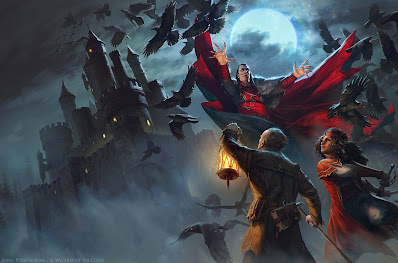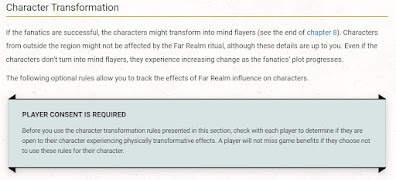Baldur's Gate 3 has been out for a few months by now, so many people have played through it at least once (a lot of people had somehow beaten it within days of it coming out, and I'm now in the third act of my second playthrough).
It's a great game - maybe the game of the year, and one of the better RPGs in recent memory. Larian managed to take 5th edition Dungeons & Dragons's tabletop engine and put it into a video game largely successfully (there are a few weird changes I don't like, but by and large they are improvements on the system). People on the internet have hailed it as either "Everything that's good about D&D" or lambasted it as "Everything that's wrong about D&D", so...welcome to D&D discourse!
The game's first act is a near-perfect video game encapsulation of a D&D sandbox, where it feels like you can go anywhere and do things in a variety of ways, and like a good Dungeon Master, the game always seems to be prepared regardless of your approach. The second act is a bit more linear, same-y, and dreary, like a DM forcing you to play Curse of Strahd, but the game is good enough at recreating the power fantasy of mid-level D&D that it's still highly enjoyable.
Then, it kind of gets messy. The companions the players has traveled with and learned to love and care about throughout the first two chapters of the game cease to have anything interesting to say about pretty much anything (or so I've heard - I intensely dislike Larian's nonplayer character companions and decided in early access I'd be playing with a custom party instead). The characters fight the big bad and the player chooses to save the world or rule the world or whatever and the game abruptly ends.
Does anything seem missing?
Oh, right.
To give Larian credit, apparently they are working on adding epilogues in a coming patch, so we'll check in on that later and see how they do.
I started playing AD&D 2e in elementary school, and from then until some time in high school, neither me nor my friends who DM'ed never really knew what we were doing. We had seen Lord of the Rings and they had read Dragonlance, so those were essentially our group's Appendix N. We tried, but, in retrospect, I don't think we were playing the sort of game that D&D is meant to be. So when I played Baldur's Gate and its sequel in high school, in a lot of ways it felt like my first real D&D experience. Now, when I'm not sure how something in my games should "feel", Baldur's Gate is one of my foremost touchstones (along with Jack Vance, Conan, Fritz Leiber, and the rest of the typical Appendix N fare).
"Tier 1", as it's known in 5e, is exploring the Sword Coast, discovering and solving local problems like the Nashkel Mines and the Iron Crisis, and trying not to die along the way. Tier 2 is when you make it to the big city and uncover the sinister plot which will plunge the region into war unless its thwarted. By Tier 3, the player is a full-fledged hero of the realm - they may draw the attention of powerful enemies and go toe-to-toe with reality-shaping spellcasters. In Tier 4, they fight an existential battle which shapes the cosmos itself, and cement their legacy, for better or worse.
Then, there's the epilogue. It just a single slide of text that tells the player what became of their companions after those adventures which are within the scope of the campaign.
Session Omega
Every few sessions or so - usually towards the end of the current quest or adventure - I'm talking to my players about what they want to do next, or if they want to do anything at all. I'm either trying to figure out what to prepare for them, or I'm trying to determine if they're ready to be done with the game. My most recent game went to 20th-level and beyond (using epic boons, ability score improvements up to 30, feats, and multiclassing for advancement beyond 20th-level), but for me, the game ends at any point when the players decide they are done, at any level.
When we all agree that we're done, we talk about what becomes of the characters. If we need to, we might schedule an entire "session" just to do so - sort of the opposite of a Session 0. Let's call it "Session Omega".
The point of this is to reach a satisfying end for the characters without needing to work it into the game itself. Of course, if a player wants their character to achieve something, they are encouraged to take the steps to do it in-game, but sometimes everyone agrees that the game is over, even though some of the characters might have unfinished business.
An example of this was the party's kobold warlock, who sold their soul to a devil early in the game to be brought back from a more-or-less TPK. After another near brush with death, it occurred to this character that if they died, they would likely be stuck in Hell as a lemure, as the devil owned their soul, and the devil's contractual obligations (bringing them back to life that one time and investing them with warlock powers) would be fulfilled. To avoid this, the warlock began conspiring to become a lich, to sequester their soul away in a phylactery so that the devil couldn't claim it. I laid out a process for the warlock to accomplish this, and over the next ten levels or so, they did it.
The same character also wanted to become the new kobold god of death, but the characters were level 20 by that time and other players had things they wanted to do with their characters. Becoming the kobold god of death was out of the scope of the campaign, but the character's story didn't feel complete until that issue was resolved.
During the campaign's "Session Omega", we talked through the "epilogues" of each character until we were satisfied that their stories were done. The kobold lich became the god of death. The eldritch knight and aspiring necromancer became their apprentice. The barbarian opened an adventurer's guild and trained the next crop of young adventurers, becoming a local legend and protector of the campaign's main city. The paladin led an army of fire giants and ghouls in a campaign against the Draconic Principalities and conquered them (and was a irresponsible ruler who did little besides starting wars). The wizard became the center of a fungoid hivemind which stretched across the world, making him omnipotent (imagine A Song of Ice and Fire's Three-Eyed Raven). The lizardman found the tarrasque in hibernation, killed it, ate it, gestated for a millenia, and became the new tarrasque, then emerged from hibernation and had to be put down by the members of the party who were still active in the world at that time.
Part of this feels wrong in some way. The story of a character is what they accomplish in-game - if you didn't do it in the game, you can't say you did it. But we all agreed - the game was over. And I love epilogues. If we had all the time in the world, and we all agreed that we wanted to spend it playing this one campaign, I'm confident that we could play out all of these scenarios.
There's another utility to these epilogues, which is to develop the DM's setting and enrich the next campaign there. A player in a future campaign can play a death cleric who worships the kobold player's character, or they might be an adventurer trained by the barbarian's guild. A future campaign could center on the problems caused by the inept rulership of the paladin conqueror. A future Circle of Spores druid could easily tie back to the fungus wizard, or the wizard could serve as the patron to a warlock (using a subclass I may or may not be working on). The lizardfolk-turned-tarrasque could be a Tier 4 encounter for a future campaign, or the start of a campaign could be framed around the emergence of the tarrasque and the ruin that the ensuing battle causes in the world.
In short, campaigns are always going to end. If the DM and players know a campaign is going to end, they should try to end it right. Epilogues give the DM and players closure, enhance the setting, and enrich future campaigns.







